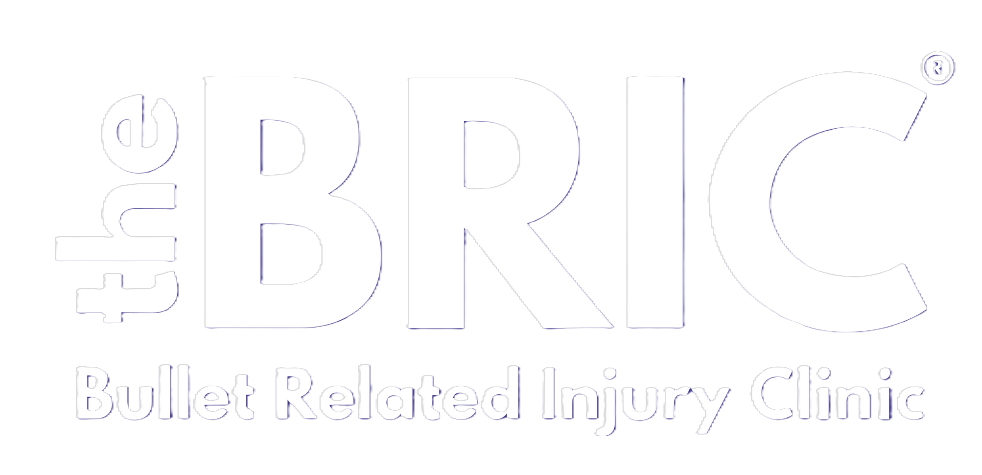What Comes Next?
When you or someone you love has just been injured by a bullet, it is normal to have a lot of questions. Here are the answers to some of the most common questions we hear at The BRIC about what comes next.
1. How long will it take to heal?
If your bullet injury did not require surgery or admission to the hospital, it all depends on how big and deep the injury is. For most injuries that have wounds on the outside that are less than an inch long or deep, and that don’t cause a broken bone, the healing time is around 3-4 weeks. Almost all skin wounds that are under an inch will heal in six weeks as long as you take care of them, keep up with your nutrition, avoid infection, and do not have any other challenges to your healing. If you have a large wound that is bigger than an inch long or deep, your healing time may be longer.
2. When will I get back to work/school/play?
It is not unusual to need at least one week away from work and school activities when you have a new bullet injury, no matter how minor it may seem. This is because the impact is almost always bigger than the body wound itself. You will need to give yourself time to resolve your trauma and heal. For many people, the physical wounds will resolve much faster than the mental and emotional ones. Getting back to day to day activities usually requires no more than once a day bandage changes, and your pain consistently under a score of 3. If your pain is higher than that, or your wound requires more than once a day bandage changes, it can be very difficult to return to a work or school day. Before then, it’s best to use your time to rest, eat, move, and heal.

3. Is it infected?
Most bullet injuries do not get infected but it is important to know the signs of infection. When your skin is broken and you have a wound, your body will leak clear or yellowish fluid out of the wound which may have some blood-tinged red color to it. Old blood is dark brown or deep red and will also sometimes drain from the wound. These are normal. Wounds may become red around the rim of the healing edge and will have some increased tenderness in the first 5-7 days after the injury.
Signs of infection can include:
- Drainage of pus, which is not clear
- Redness or discoloration around the edges of the wound that extends far beyond the wound
- Severe tenderness that hurts much worse than the original injury
- Severe swelling
- Bad odor
- Fever
If you are concerned about infection it is best to get in touch with a medical provider to give you guidance on how to care for the wound.
4. Why does my injury feel “weird”
When a bullet goes through our tissue, it creates a direct injury and blast effect. This means the bullet cuts through the tissues in its path, and it also creates a field of vibration and injury around the path it takes. This causes further damage to the tissue even beyond the area the bullet traveled through. These combined injuries can often affect the nerves that give feeling to the area of the injury. Whether the nerve has been cut or damaged, the normal nerve signals don’t get through. Nerves are like radio waves that play on a radio. When they are not tuned in to a channel, all we hear is static. And that static can feel like a weird combination of numbness, burning, tingling, and pain. Often, patients say the feeling is something they can’t describe. The medical term for this feeling is neuropathic pain. It's the pain that comes when our nerves themselves are injured. It is a difficult kind of pain to manage because damaged nerves are hard to keep quiet.
We take a 3 STEP approach to managing neuropathic pain which includes:
- Improve nerve nutrition: Giving our nerves the right nutrition helps them heal. This can include supplements like B-complex, alpha lipoic acid & Omega 3's.
- ‘Tuning’ into a new nerve signal: We can manage the discomfort of neuropathic pain by giving our nerves a new signal to “tune in to”. We can do this by using gentle massage and exercise.
- Turning the nerve volume down: Sometimes we need to turn the pain signal down. We can do this with the use of over the counter medications like acetaminophen, ibuprofen and magnesium glycinate supplements.
5. You are safe now
When we have trauma, it is normal to feel like nowhere and no one is safe. That is our body’s lifesaving survival mechanism, keeping us away from further harm. We can also give our body a new message, letting it know that we are safe now. By giving this message to ourselves, through writing it, saying it, looking at it and hearing it, we open a new possibility for ourselves, a possibility that we can stop re-living the worst days of our lives. You can put a You Are Safe Now message on your phone, on your mirror, next to your bed, or say it out loud while you are doing your breathing exercises. Being safe includes feeling safe, and you can make choices to guard your safety as you continue to heal from your injury. This might mean walking away from stressful situations where it is difficult to manage emotions. It might mean giving our friends and family a break, knowing they don’t mean to hurt us, but that we are having a hard time believing anyone is safe right now. It can mean taking things a little slower and giving ourselves extra time to manage the day-to-day, so we don’t overwhelm ourselves.

